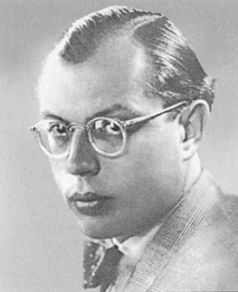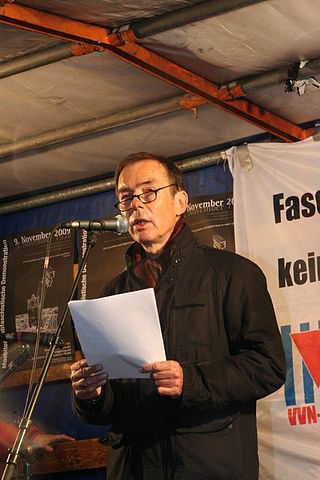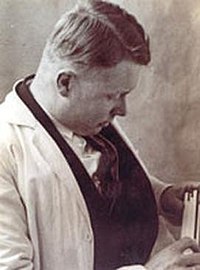
The Red Orchestra was the name given by the Abwehr Section III.F to anti-Nazi resistance workers in Germany in August 1941. It primarily referred to a loose network of resistance groups, connected through personal contacts, uniting hundreds of opponents of the Nazi regime. These included groups of friends who held discussions that were centred on Harro Schulze-Boysen, Adam Kuckhoff and Arvid Harnack in Berlin, alongside many others. They printed and distributed prohibited leaflets, posters, and stickers, hoping to incite civil disobedience. They aided Jews and resistance to escape the regime, documented the atrocities of the Nazis, and transmitted military intelligence to the Allies. Contrary to legend, the Red Orchestra was neither directed by Soviet communists nor under a single leadership. It was a network of groups and individuals, often operating independently. To date, about 400 members are known by name.

Wilhelm Guddorf was a Belgian journalist, anti-Nazi and resistance fighter against the Third Reich. Guddorf was a leading member of a Berlin anti-fascist resistance group that was later called the Red Orchestra by the Abwehr. Guddorf was the editor of the Communist Die Rote Fahne newspaper.

Hans-Wedigo Robert Coppi was a German resistance fighter against the Nazis. He was a member of a Berlin-based anti-fascist resistance group that was later called the Red Orchestra by the Gestapo.

Arvid Harnack was a German jurist, Marxist economist, Communist, and German resistance fighter in Nazi Germany. Harnack came from an intellectual family and was originally a humanist. He was strongly influenced by Johann Wolfgang von Goethe but progressively moved to a Marxist-Socialist outlook after a visit to the Soviet Union and the Nazis' appearance. After starting an undercover discussion group based at the Berlin Abendgymnasium, he met Harro Schulze-Boysen, who ran a similar faction. Like numerous groups in other parts of the world, the undercover political factions led by Harnack and Schulze-Boysen later developed into an espionage network that supplied military and economic intelligence to the Soviet Union. The group was later called the Red Orchestra by the Abwehr. He and his American-born wife, Mildred Fish, were executed by the Nazi regime in 1942 and 1943, respectively.

Mildred Elizabeth Harnack was an American literary historian, translator, and member of the German resistance against the Nazi regime. After marrying Arvid Harnack, she moved to Germany in 1929, where she began her career as an academic. Mildred Harnack spent a year at the University of Jena and the University of Giessen working on her doctoral thesis. At Giessen, she witnessed the beginnings of Nazism. Mildred Harnack became an assistant lecturer in English and American literature at the University of Berlin in 1931.

Heinz Harro Max Wilhelm Georg Schulze-Boysen was a left-wing German publicist and Luftwaffe officer during World War II. As a young man, Schulze-Boysen grew up in prosperous family with two siblings, with an extended family who were aristocrats. After spending his early schooling at the Heinrich-von-Kleist Gymnasium and his summers in Sweden, he part completed a political science course at the University of Freiburg, before moving to Berlin in November 1929, to study law at the Humboldt University of Berlin. At Humboldt he became an anti-Nazi. After a visit to France in 1931, he moved to the political left. When he returned, he became a publicist on Der Gegner, a left-leaning political magazine. In May 1932, he took control of the magazine, but it was closed by the Gestapo in February 1933.

Libertas "Libs" Schulze-Boysen, born Libertas Viktoria Haas-Heye was a German Prussian noblewoman, who became a resistance fighter against the Nazis. From the early 1930s to 1940, Schulze-Boysen attempted to build a literary career, first as a press officer and later as a writer and journalist. Initially sympathetic to the Nazis, she changed her mind after meeting and marrying Luftwaffe officer Harro Schulze-Boysen. As an aristocrat, Schulze-Boysen had contact with many different people in different strata of German society. Starting in 1935, she utilized her position to recruit left-leaning Germans into discussion groups which she hosted at her and Harro's apartment, where they sought to influence her guests. Through these discussions, resistance to the Nazi regime grew, and by 1936, she and Harro began to actively resist the Nazis. During the early 1940s, whilst working as a censor for the German Documentary Film Institute, Schulze-Boysen began to document atrocities committed by the Nazis from photographs of war crimes forwarded by soldiers of the Sonderbehandlungen task force to the Film Institute.

Hans Coppi Jr. is a German historian. His parents, Hilde and Hans Coppi, were active in the German Resistance and were both executed by the Nazis.
![<i>KLK Calling PTZ – The Red Orchestra</i> 1971 [[East Germany]] film](https://upload.wikimedia.org/wikipedia/commons/thumb/8/83/Bundesarchiv_Bild_183-K0325-0043-001%2C_Berlin%2C_Filmpremiere_%22...Rote_Kapelle%22.jpg/320px-Bundesarchiv_Bild_183-K0325-0043-001%2C_Berlin%2C_Filmpremiere_%22...Rote_Kapelle%22.jpg)
KLK Calling PTZ – The Red Orchestra is a 1971 East German film about the history of the Red Orchestra espionage ring.
General der Nachrichtenaufklärung was the signals intelligence agency of the Heer, before and during World War II. It was the successor to the former cipher bureau known as Inspectorate 7/VI in operation between 1940 and 1942, when it was further reorganised into the Headquarters for Signal Intelligence between 1942 and 1944, until it was finally reorganised in October 1944 into the GdNA. The agency was also known at the OKH/Gend Na, GendNa or Inspectorate 7 or more commonly OKH/GdNA. Inspectorate 7/VI was also known as In 7 or In/7 or In 7/VI and also OKH/Chi.

Heinrich Scheel was a German left-wing historian and longtime vice president of the East German Academy of Sciences and professor of modern history at Humboldt University of Berlin. Scheel was notable for putting forward a theory of the German radical at the time of the French revolution, in an attempt to determine an alternative tradition in Germany. Scheel was most notable for being a German resistance fighter against the Nazi regime, during World War II. He was a member of a Berlin-based anti-fascist resistance group that was later called the Red Orchestra by the Abwehr, during the Nazi regime.

Horst Heilmann was a German resistance fighter against the Nazi regime. He was a member of the anti-fascist resistance group that formed around Harro Schulze-Boysen in 1940. Later, the people of the group along with many others were bundled together and called the Red Orchestra by the Abwehr. Heilmann was a student and a wireless operator who worked at the Referat 12 that was in the Inspectorate 7/VI.

Anatoly Markovich Gurevich was a Soviet intelligence officer. He was an officer in the GRU operating as "разведчик-нелегал" in Soviet intelligence parlance. Gurevich was a central figure in the anti-Nazi Red Orchestra in France and Belgium during World War II.

Wolfgang Kreher Johannes "John" Graudenz was a German journalist, press photographer, industrial representative and resistance fighter against the Nazi regime. Graudenz was most notable for being an important member of the Berlin-based anti-fascist resistance group that would later be named by the Gestapo as the Red Orchestra and was responsible for the technical aspect of the production of leaflets and pamphlets that the group produced.
Hans Karl Georg Heinrich Pietsch was a German mathematician who was most notable for being a director of the Mathematical Referat of the Wehrmacht signals intelligence agency, the General der Nachrichtenaufklärung during World War II.
Gisela von Pöllnitz was a German journalist, communist, and resistance fighter against the Nazi regime. During the Nazi regime, she was a notable member of the Berlin-based anti-fascist resistance group around Harro Schulze-Boysen, later called the Red Orchestra by the Abwehr. Throughout her life von Pöllnitz had a lung condition that progressively worsened after being arrested several times by the Gestapo. On her final arrest by the Gestapo she contracted tuberculosis after 5 months in custody. Her physician Elfriede Paul arranged a sanitarium in Switzerland, but she never recovered.
Sonderkommando Rote Kapelle was a German special commission that was created by German High Command in November 1942, in response to the capture of two leading members of a Soviet espionage group that operated in Europe, that was called the Red Orchestra by the Abwehr. The Sonderkommando Rote Kapelle was an internal counter-intelligence operation run by the Abwehr and the Gestapo. It consisted of a small independent Gestapo unit that was commanded by SS-Obersturmbannführer Friedrich Panzinger and its chief investigator was Gestapo officer Karl Giering. Its remit was to discover and arrest members of the Red Orchestra in Germany, Belgium, France, Netherlands, Switzerland and Italy during World War II.

Herbert Gollnow was a German resistance fighter, consulate secretary and later second lieutenant in the Luftwaffe. Gollnow career was influenced by Harro Schulze-Boysen while Gollnow studied at the Faculty for Foreign Studies of the Friedrich Wilhelm University in Berlin, and as he rose through the ranks of the Luftwaffe, he became a counter-intelligence officer in the Luftwaffe and an informer to Schulze-Boyen. Gollnow became a member of a Berlin anti-fascist resistance group that was associated with Schulze-Boysen, that was later called the Red Orchestra. He was later arrested and executed in 1943.
Friedrich Rehmer was a German factory worker and resistance fighter against the Nazi regime. While attending an evening school in Schöneberg, Rehmer met a group of friends that included Ursula Goetze, Otto Gollnow, Hannelore Thiel, Liane Berkowitz, John Rittmeister and Werner Krauss. In December 1941, he became part of an anti-fascist network after meeting Harro Schulze-Boysen through Wolfgang Rittmeister, brother to John Rittmeister. The network was later called the Red Orchestra by the Abwehr. Rehmer was executed in 1943.

Walter Husemann was a German communist and resistance fighter against the Nazi regime. As a young man, Husemann trained an industrial toolmaker, before training as a journalist. He became interested in politics and joined the Communist Party of Germany (KPD). With the arrival of the Nazis in 1933, he became a resistance fighter and through his wife, the actor Marta Husemann, he became associated with an anti-fascist resistance group around Harro Schulze-Boysen and Arvid Harnack that was later called the Red Orchestra by the Gestapo. Along with John Sieg whom he met in the KPD and Fritz Lange, Martin Weise and Herbert Grasse he wrote and published the resistance magazine, The Internal Front Die Innere Front.









![<i>KLK Calling PTZ – The Red Orchestra</i> 1971 [[East Germany]] film](https://upload.wikimedia.org/wikipedia/commons/thumb/8/83/Bundesarchiv_Bild_183-K0325-0043-001%2C_Berlin%2C_Filmpremiere_%22...Rote_Kapelle%22.jpg/320px-Bundesarchiv_Bild_183-K0325-0043-001%2C_Berlin%2C_Filmpremiere_%22...Rote_Kapelle%22.jpg)





